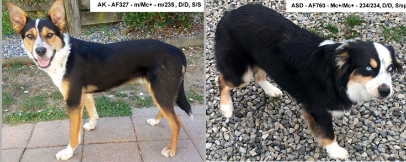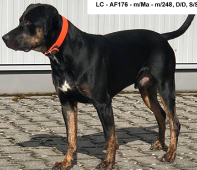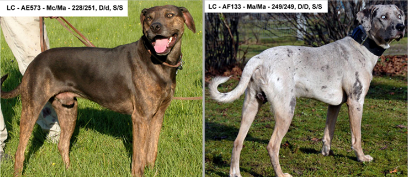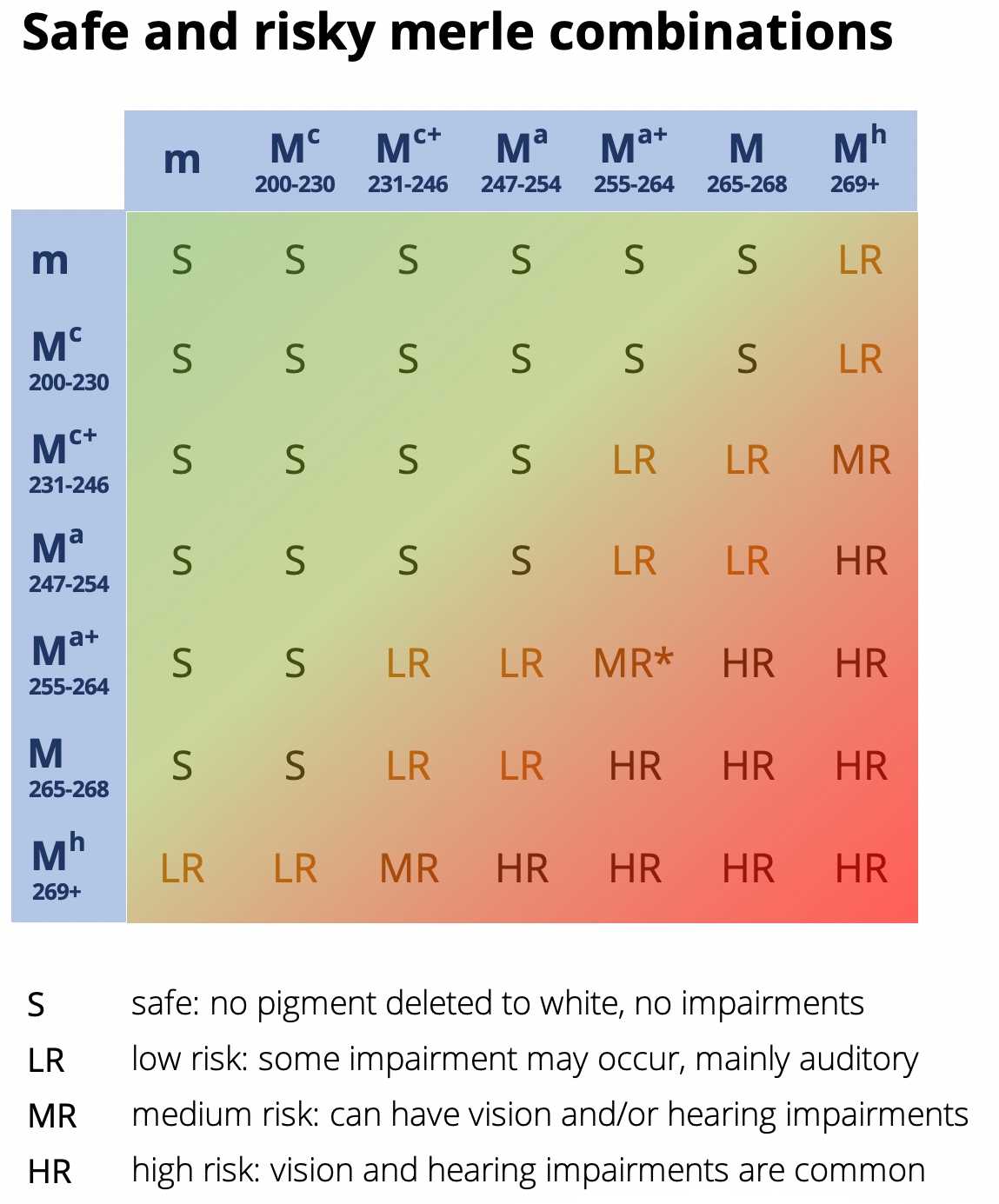
Testing of dogs: Locus M (Merle)
Related tests
- Combi Dachshund Miniature Long-haired 2 Premium SNP DNA profile (ISAG 2020) + Cord1-PRA + Locus M (Merle)
- Merle + White spotting coat color combination test of merle and white spotting
Merle coloration in dogs
Merle, characterized by phenotypic changes in many dog breeds, has been a studied phenomenon for a long time. The mutation was first detected in 2006. Clark et al. identified a short SINE insertion within the SILV pigment gene. SINE insertions are widely known to insert into different regions of the genome and cause changes in gene expression, knock a gene out of function, or cause the development of an inherited disease. This property may make them one of the driving forces of evolution. The SINE insertion in the SILV gene leads to the inability of cells to produce normal pigment. The degree of expression in the phenotype is associated with the variable length of the insertion polyA tail (a chain of repetitive base pairs, which is one of the components of the SINE insertion). The longer the insertion polyA tail, the greater the degree of expression in the phenotype can be observed.
The merle trait is inherited in an autosomal, incompletely dominant way. The dominant allele cannot completely suppress the influence of the recessive allele, which is therefore also partially expressed. The resulting colour and pattern are determined by which alleles the offspring receives from the parents. The expression of merle alleles varies from generation to generation and the offspring are often phenotypically different from the parents and from each other. The polyA tail may also vary within individual cells of a given dog - the dog thus appears as a merle mosaic. As merle colouration is associated with health risks, it is important that breeders are consistent and avoid pairing incompatible individuals, which can lead to offspring with a genotype associated with serious health problems. Breeds with merle pattern include: Australian Shepherd, Australian Koolie, Border Collie, Chihuahua, French Bulldog, Dachshund, Collie Longhair, Catahoula Leopard Dog, Miniature American Shepherd, Miniature Australian Shepherd, Mudi, Great Dane, German Spitz, Prague Ratter, Pyrenean Shepherd, Sheltie, Welsh Corgi Cardigan, Yorkshire Terrier, and others.
The discovery of the SINE insertion in the SILV gene was very fundamental, but still insufficient for an overall understanding of merle. Langevin et al. (2018) and Murphy et al. (2018) went even further in their studies to analyse merle. Murphy et al. (2018) detected 4 types of merle - cryptic (Mc; 25-55 bp), dilute (Md; 66-74 bp), standard (M; 78-86 bp), and harlequin (Mh; 81-105 bp). Langevin et al. (2018) detected a total of 7 different merle alleles, which can produce up to 28 different allele combinations between them. It was their discovery that finally gave a meaningful explanation of merle inheritance to many breeders, who until then often struggled with incomplete and incomprehensible results.
.
Alleles of the merle locus:
- m – non-merle (original, no SINE insertion present)
- Mc – cryptic merle (polyA length 200 – 230 bp)
- Mc+ – cryptic merle + (polyA length 231 – 246 bp)
- Ma – atypical merle (polyA 247 length – 254 bp)
- Ma+ – atypical merle + (polyA 255 length – 264 bp)
- M – classic merle (polyA length 265 – 268 bp)
- Mh – harlequin merle (polyA length 269 – 280 bp)
Allele combination: m/m, m/Mc, Mc/Mc, Mc/Mc+, m/Mc+, Mc+/Mc+, m/Ma, Mc/Ma, Mc+/Ma, Ma/Ma, m/Ma+, Mc/Ma+, Mc+/Ma+, Ma/Ma+, Ma+/Ma+, m/M, Mc/M, Mc+/M, Ma/M, Ma+/M, M/M, m/Mh, Mc/Mh, Mc+/Mh, Ma/Mh, Ma+/Mh, M/Mh, Mh/ Mh
It is very important to know which combination of alleles the dog carries. Some combinations have been mistakenly considered risky in the past and the dogs in question were unnecessarily eliminated from breeding. This is especially the case with the Mc allele. Another reason is that merle colouring may not be visible at first sight and the dog is wrongly labelled as non-merle. An example of this is locus E, where the e/e genotype suppresses the expression of merle colour, the same situation is also the case with locus A and the ay/ay genotype. Only the Mh allele can circumvent these two exceptions and produce a weak merle pattern in dogs where merle is masked by e/e or ay/ay. Then there is merle mosaicism, where the cells of the dog contain a higher percentage of truncated alleles and the dog may also be mistaken for a non-merle.
.
Mc allele – cryptic merle (polyA length 200 – 230 bp)
A dog that carries the Mc allele is solid colour. The combination of m/Mc, Mc/Mc alleles has no effect on the phenotype, the dog shows no signs of merle colouration. The polyA tail of this allele is so truncated that this allele with its zero effect on the phenotype can be considered as non-merle. Dogs genetically tested as m/Mc or Mc/Mc may mate with dogs carrying the M allele.
.
Mc+ allele – cryptic merle + (polyA length 231 – 246 bp)
The combinations of Mc/Mc+, m/Mc+, Mc+/Mc+ alleles also carry no health risk. Dogs in most cases do not have phenotypic merle manifestation, there is no change in coat colour or pigment shading. Only rarely in long-haired breeds can a slight change of pigment occur, when the coat appears slightly faded or a brownish tint may appear, which is not related to the influence of the B locus and the b/b genotype. Mc/Mc+, m/Mc+, Mc+/Mc+ can be paired with individuals carrying the M allele.
Fig.: Overview of genotypes m/Mc+, Mc+/Mc+ and their possible phenotypic manifestations (Langevin et al. 2018)

.
Ma allele – atypical merle (polyA length 247 – 254 bp)
The Ma allele is already expressed more in the phenotype. In combinations of the m/Ma, Mc/Ma and Mc+/Ma alleles, the coat colour may appear diluted, or a brownish tint may appear. In long-haired breeds, a lighter undercoat may be visible. Light shading may be seen in the neck, ears, and tail areas. The dog may have blue eyes. In the Ma/Ma combination, small dark patches may appear on the coat on a light shaded undercoat. The Ma allele, in combination with alleles of the longer polyA tail can potentially produce white markings on the coat. It is generally not recommended to pair dogs that are of the Ma genotype with dogs carrying the M or Mh allele.
Fig.: Overview of genotypes m/Ma, Mc/Ma, Ma/Ma and their possible phenotypic manifestations (Langevin et al. 2018).


.
Ma+ allele – atypical merle + (polyA length 255 – 264 bp)
In m/Ma+ and Mc/Ma+ allelic combinations, the merle pattern tends to be more subdued. The colour is diluted or brownish, with shaded pigment. However, some dogs remain without a visible merle pattern. The eyes may be blue in colour. The Mc+/Ma+ variant already shows a higher degree of dilution. The diluted colour may be accompanied by a small number of smaller dark spots. The pigment may be diluted to white. As the number of bases increases, a so-called tweed colouration may be present, where more extensive uniformly coloured areas appear in the dog. The closer the number of Ma+ bases is to the M allele, the more likely the dog is to have pigment deletion to white. Ma/Ma+, Ma+/Ma+ individuals are mostly already tweed coloured, the pigment is deleted to white, and the colour is diluted. It is generally not recommended to pair dogs that are Ma+ genotype with dogs carrying the M or Mh allele.
Fig.: Overview of genotypes m/Ma+, Mc/Ma+, Mc+/Ma+, Ma+/Ma+ and their possible phenotypic manifestations (Langevin et al. 2018)

.
M – merle (polyA length 265 – 268 bp)
The M allele can occur in a total of 7 allelic combinations with variable levels of merle trait expression. The longer the polyA tail of the alleles combined with the M allele, the greater the phenotypic expression can be observed. The m/M individuals have the classic merle pattern - varying areas of coat where the pigment is diluted to lighter shades. Such coloured areas are interspersed with areas where the coat is fully pigmented. In this allelic combination, the pigment is not diluted to white. The dog may have blue eyes. The Mc/M genotype is also characterised by a combination of variously large dilute and fully pigmented areas. Dogs may have a tweed pattern and blue eyes. The same features can also be observed in the Mc+/M combination, but here there is already the possibility of pigment deletion to white colouration. The Ma/M genotype is associated with a merle pattern called patchwork. In addition to the classic merle combination of diluted/fully pigmented colour, a small number of small, dark patches are present in the coat. In the Ma+/M variant it is possible to observe the so-called Irish spotting pattern - the head, legs and shoulders often have a deleting of the pigment to white. The penultimate of the M/M genotypes (double merle) is characterised by variable areas of dilute/full pigmentation, with areas of variably spread white colour. The last allelic combination Mh/M is mentioned in the next paragraph. Dogs carrying two M alleles very often suffer serious health problems (especially hearing and vision loss). Dogs carrying the M allele should preferably only be paired with dogs that do not carry an allele other than m or Mc.
Fig.: Overview of m/M genotypes. Mc/M, Mc+/M, Ma/M, Ma+/M, M/M and their possible phenotypic manifestations (Langevin et al. 2018)

.
Mh – harlequin merle (polyA length 269 – 280 bp)
The Mh allele is characterized by high variability of phenotypic expression. Typical phenotypes of the Mh allele include minimal merle - most of the body is coloured normally, only the peripheral parts - head, shoulders, legs, may have merle features. It happens that the traits are so minimal that they are almost unnoticeable. Furthermore, the expression of the Mh allele creates the so-called shepherd harlequin (typical especially for Australian Shepherds and Border Collies). These dogs have large areas where the grey colour is diluted to white or light grey. The degree of expression varies depending on the length of the polyA tail. Allelic combinations of m/Mh, Mc/Mh, Mc+/Mh, Ma/Mh, Ma+/Mh, M/Mh, Mh/Mh are phenotypically indistinguishable in most cases. However, a higher percentage of white colour can be observed in M/Mh, Mh/Mh. Dogs carrying the Mh allele should not be paired with anyone carrying an allele other than M or Mc in their genotype (even with this combination, however, there is no guarantee that the dog will not suffer from health problems). However, in case of incorrect pairing with an individual carrying an allele with a longer polyA tail, the risk of disability is much higher (hearing loss, loss of vision).
Fig.: Overview of genotypes m/Mh, Mc/Mh, Mc+/Mh, Ma/Mh, M/Mh, Mh/Mh and their possible phenotypic manifestations (Langevin et al. 2018)

.
Summary
A total of 14 allelic combinations causes deletion of the pigment to white: Mc+/Ma+, Ma/Ma+, Ma+/Ma+ Mc+/M, Ma/M, Ma+/M, M/M, m/Mh, Mc/Mh, Mc+/Mh, Ma/Mh, Ma+/Mh, M/Mh, Mh/Mh.
A total of 8 allelic combinations are at risk of disability: M/M, m/Mh, Mc/Mh, Mc+/Mh, Ma/Mh, Ma+/Mh, M/Mh, Mh/Mh.

.
Merle mosaic
Merle mosaic occurs to a large extent in many dog breeds. It is the presence of two or more cells with different genotypes within the body of a given individual. The mosaic can occur early in embryonic development when the length of the SINE insertion polyA tail changes within a single cell. Subsequent replication of the cell leads to the expansion of this new merle allele. Thus, more than two merle alleles can be detected in the tested dog. Merle mosaicism leads to unusual phenotypes that are atypical and cannot be classified under any allelic combination. A new merle allele is either generated within a somatic cell - the resulting effect on the phenotype can only be observed in the specific individual. However, it is not uncommon for a new allele to arise in a cell belonging to the reproductive cells. Such a cell may already be passed on to the next generation of offspring and lead to unusual merle patterns. By fragmentation analysis of an individual that is a merle mosaic, it is possible to see which merle alleles are majority or minority in the dog. However, the proportion of these alleles may vary depending on the genetic material from which the test was performed (oral mucosal swab x semen).
.
Reference:
Ballif, B. C., Emerson, L. J., Ramirez, C. J., Carl, C. R., Sundin, K., Flores-Smith, H., & Shaffer, L. G. (2021). The PMEL gene and merle (dapple) in the dachshund: cryptic, hidden, and mosaic variants demonstrate the need for genetic testing prior to breeding. Human Genetics. doi:10.1007/s00439-021-02330-y
Clark LA, Wahl JM, Rees CA, Murphy KE (2006) Retrotransposon insertion in SILV is responsible for merle patterning of the domestic dog. Proceedings of the National Academy of Sciences of the United States of America 103: 1376–1381. https://doi.org/10.1073/pnas.0506940103 PMID: 16407134
Langevin, M., Synkova, H., Jancuskova, T., & Pekova, S. (2018). Merle phenotypes in dogs – SILV SINE insertions from Mc to Mh. PLOS ONE, 13(9), e0198536. doi:10.1371/journal.pone.0198536
Murphy, S.C., Evans, J.M., Tsai, K.L. et al. Length variations within the Merle retrotransposon of canine PMEL: correlating genotype with phenotype. Mobile DNA 9, 26 (2018). https://doi.org/10.1186/s13100-018-0131-6
Pelles, Z., Gáspárdy, A., Zöldág, L., Lénárt, X., Ninausz, N., Varga, L., & Zenke, P. (2019). Merle allele variations in the Mudi dog breed and their effects on phenotypes. Acta Veterinaria Hungarica, 67(2), 159–173 doi:10.1556/004.2019.018
Varga, L.; Lénárt, X.; Zenke, P.; Orbán, L.; Hudák, P.; Ninausz, N.; Pelles, Z.; Szőke, A. Being Merle: The Molecular Genetic Background of the Canine Merle Mutation. Genes 2020, 11, 660. https://doi.org/10.3390/genes11060660



